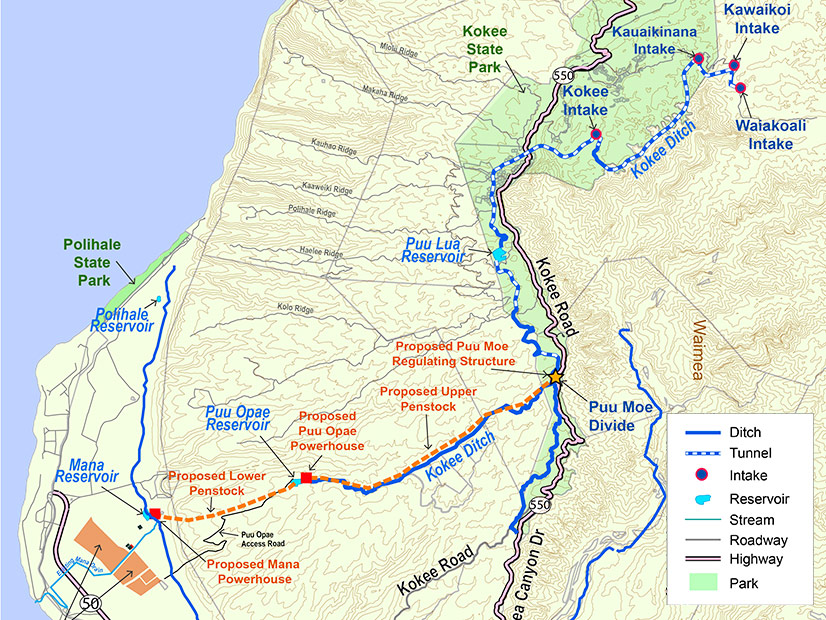Hawaii’s Public Utilities Commission last week approved construction of the West Kauai Energy Project (WKEP), a pumped storage hydropower (PSH) project designed to provide the island with 110 GWh in annual output.
Located on the west side of Kauai near the town of Waimea, WKEP will be constructed and operated by AES and owned by the Kauai Island Utility Cooperative (KIUC).
WKEP is a multifaceted project that will generate electricity via hydropower, store and release electricity using a solar PV/battery-electric storage system (BESS) and provide irrigation to support nearby agriculture.
The PSH will utilize two powerhouses with the PV/BESS. Water will flow from diverted rivers down the mountain into the Puu Lua Reservoir. From there, some water will be diverted to irrigation while the rest will flow down to the Puu Opae Reservoir and its powerhouse, generating 4 MW or an estimated 13 GWh annually. The water will then flow down to the Mana Reservoir and its powerhouse, generating 20 MW or an estimated 13 GWh annually.
The PV/BESS system near the Mana Reservoir will generate 35 MW, some of which will go directly to Kauai’s energy grid, and the rest will go to pumping the water from the Mana Reservoir back up to the Puu Opae Reservoir in a continuous loop.
KIUC estimates that from the energy produced from PV, 48% will be used to power the Mana Pumphouse, 31% will go directly to Kauai’s energy grid and 21% will be sent to the BESS.
The PUC order (38095) approving the project notes that the BESS “will be DC-coupled to the PV array and thus will be able to follow the variability of the PV array’s energy production caused by passing cloud cover to ensure constant PV power for pumping while also harvesting otherwise clipped/lost energy.”
KIUC says the project will provide reliability through energy storage, noting the PSH portion of WKEP will offer “firm, dispatchable renewable energy, averaging 26 GWh annually, that can be delivered to the grid mainly during the evening peak, nighttime and morning peak hours but also during periods of cloudy/rainy weather, thereby displacing fossil fuel energy.”
The utility expects the project to reduce fossil fuel use by 8.5 million gallons annually, which would allow the project to contribute 22.72% to KIUC’s renewable portfolio standard (RPS). In addition, KIUC estimates that WKEP will offset approximately 2.5 million GHGs over the project’s lifecycle.
KIUC estimates that WKEP will save its customers “between $157 million and $172 million” over 25 years.
The project will also rehabilitate the Puu Lua Reservoir for community recreation. KIUC also notes that WKEP “should assist in mitigating future flooding risks. … The repairs to the Puu Lua Reservoir, Puu Opae Reservoir and Mana Reservoir will bring the reservoirs into compliance with Hawaii State Dam Safety Standards, which [will] provide some protection from flooding for downstream lands and greatly decrease the risk of a dam breach.”
Kauai residents and environmental groups previously raised concerns about WKEP related to land use for solar panels, the location of piping for the hydro portion of the project and the potential for discharge of fresh water into nearby coral reefs. (See Kauai Solar + Pumped Hydro Project Raises Concerns.)
Residents asked that the PUC not approve the project until it undergoes a Hawaii Environmental Policy Act (HEPA) review, but the commission accepted KIUC’s assurances that it would provide quarterly updates regarding the review and reserved the right to take “appropriate” action in response.
AES can begin construction once a HEPA review has been completed and it has acquired all necessary permits for construction and operation.


